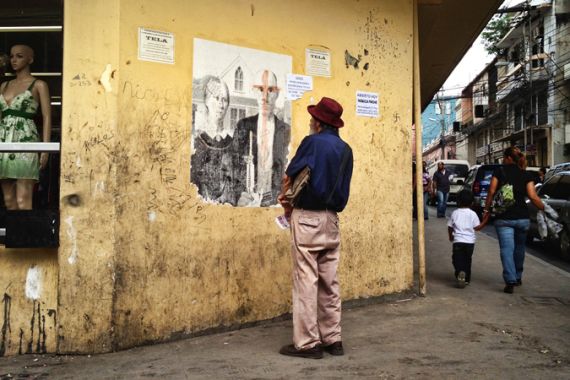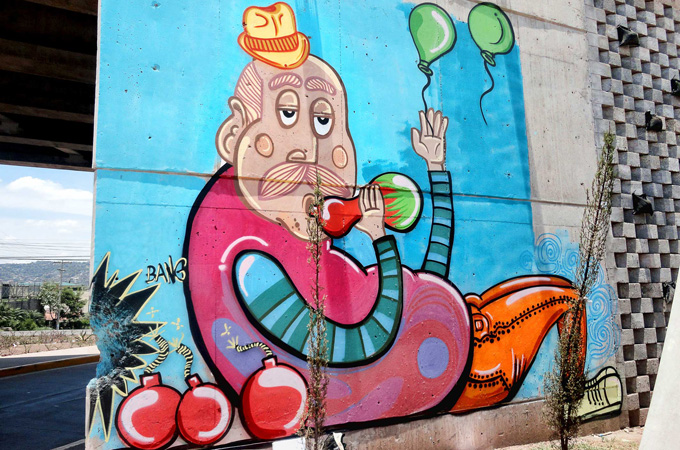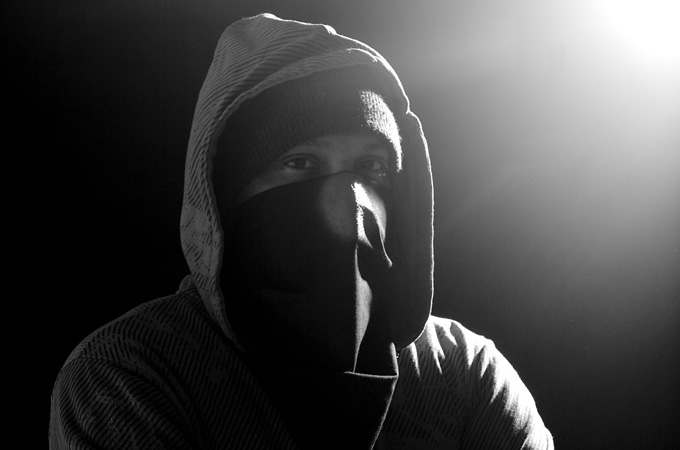Fighting guns with graffiti in Honduras
Tegucigalpa has become one of the world’s deadliest cities and one artist wants to highlight the problem through paint.

Tegucigalpa, Honduras – It’s almost sundown and a small sport utility vehicle glides through one of the most dangerous cities in the world which has been overrun by rival gangs and organised crime.
During the drive, dozens of Hondurans are seen making their way home, wary of the time to ensure they get there before dark. The SUV crosses a bridge and parks on the sidewalk, just two blocks away from the capital Tegucigalpa’s red-light district.
It is here where Urban Maeztro, a 27-year-old ad agency employee turned street artist is preparing to send a message about violence in this Central American country. Armed with two boxes of spray paint cans, a notebook, and a Sharpie marker, he plans to take over the six-metre long wall.
“Every 87 minutes someone dies in Honduras from a firearm, and there are over 650,000 illegal weapons. This piece will speak to that,” Maeztro tells Al Jazeera.
Tegucigalpa has become one of the world’s deadliest cities with more than 87 homicides per 100,000 people – 10 times the rate considered an epidemic of violence by the World Health Organisation.
|
“This is a country where people and [political] parties plaster propaganda and slogans on walls. This is so cool and I’d rather see this.“ – Denis Hernandez, delivery driver |
The figure has increased more than 232 percent since 2005, according to the Autonomous National University of Honduras’s Observatory of Violence.
“The one and only thing that people know about my country is the violence. It is what paints our reality,” says the graffiti artist who began his project a year ago.
Maeztro only uses his street name, a pun of “Urban Master”, to protect his identity, saying his work is illegal and dangerous.
Maeztro says he’s been fired at with a weapon from a moving pick-up truck while performing his artwork. “It’s a culture of intolerance. I disagree with you and I just kill you,” he says.
Usually the artist dons a ski mask or a bandana to hide his identity, however, on a recent afternoon he agreed to show his face to during a graffiti assault.
New advertising
In a matter of seconds, Maeztro slaps on a thick coat of white paint on the wall as primer.
He delineates a grotesque head with a green spray can – an outline reminiscent of Colombian figurative artist Fernando Botero’s characters with an exaggerated and disproportionate volume, as well as scathing criticism.
He continues spraying on layer after layer. The head is now bright orange with coiffed hair and a moustache. The figure is biting a bullet.
“This character represents so many Honduran politicians,” Maeztro says, pausing to smoke a cigarette and wait for a layer to dry. Dozens of cars slow down before the traffic light to observe the visual intervention.
A deliveryman suddenly pulls up on a motorcycle and asks Maeztro for his phone number; he has friends that are interested in learning how to do street art.
 |
| Political graffiti in Honduras [Urban Maeztro/Al Jazeera] |
“This is a country where people and [political] parties plaster propaganda and slogans on walls,” says the driver Denis Hernandez, 23. “This is so cool and I’d rather see this.”
When asked why he decided to make the jump from an advertising agency to graffiti, Maestro says it was actually marketing and working at a company that taught him how streets could be used to send all kinds of messages.
“In advertising, I was taught billboards condition human behaviour. So as an artist, I take to the streets to engage, and attempt to generate a social consciousness”.
Touring other works
Many other graffiti displays are scattered all over Tegucigalpa, and not all are political. Maeztro’s first series was a set of mixed paintings where he used internationally renowned works such as Leonardo Da Vinci’s “Mona Lisa” and Grant Wood’s “American Gothic” to capture pedestrians’ attention.
He then contrasts these images with a neon drawing of a weapon; the Mona Lisa holds a 9mm pistol, while in the Gothic piece, the farmer holds a neon magenta M-16 assault rifle instead of the iconic pitchfork.
“The 9mm gun is the most used handgun by the country’s police,” says Maeztro.
Like many Hondurans, Maeztro has been a victim of this country’s increasingly problematic police force.
This country’s police and army have come under fire in recent months with allegations that they have carried out and covered up extrajudicial assassinations targeting youths as part of so-called social cleansing campaigns.
A recent US State Department report said corruption and impunity continued to be serious problems within the national police, including allegations of violent crime, extortion, kidnappings and illegal detentions committed by officers.
At the abandoned street corner emblazoned with Maeztro’s Mona Lisa with a gun, Eliezer Cruz, a 23-year-old bodyguard, walks by the painting.
 |
| Urban Maeztro |
When asked what he thinks he pauses. “She is very well known, but in many ways so is that gun.”
New movement
While Maeztro’s work began as a solo act, two other urban artists are now tagging and staging graffiti interventions alongside him.
Together, they have created the Garawa Collective. Garawa is a type of bird in the Garifuna language, an African-descended ethnic minority in Honduras.
Code, 38 and Caraqui, 27, both say they had been working in obscurity and independently until they met Maeztro.
“We saw the opportunity to do something together,” says Code, who also spoke about Maeztro’s work trying to recruit young gang members to keep them out of trouble.
Maeztro says urban artists will eventually take back Honduran streets. “The movement is growing. It’s about people waking up and demanding something more, something better.”